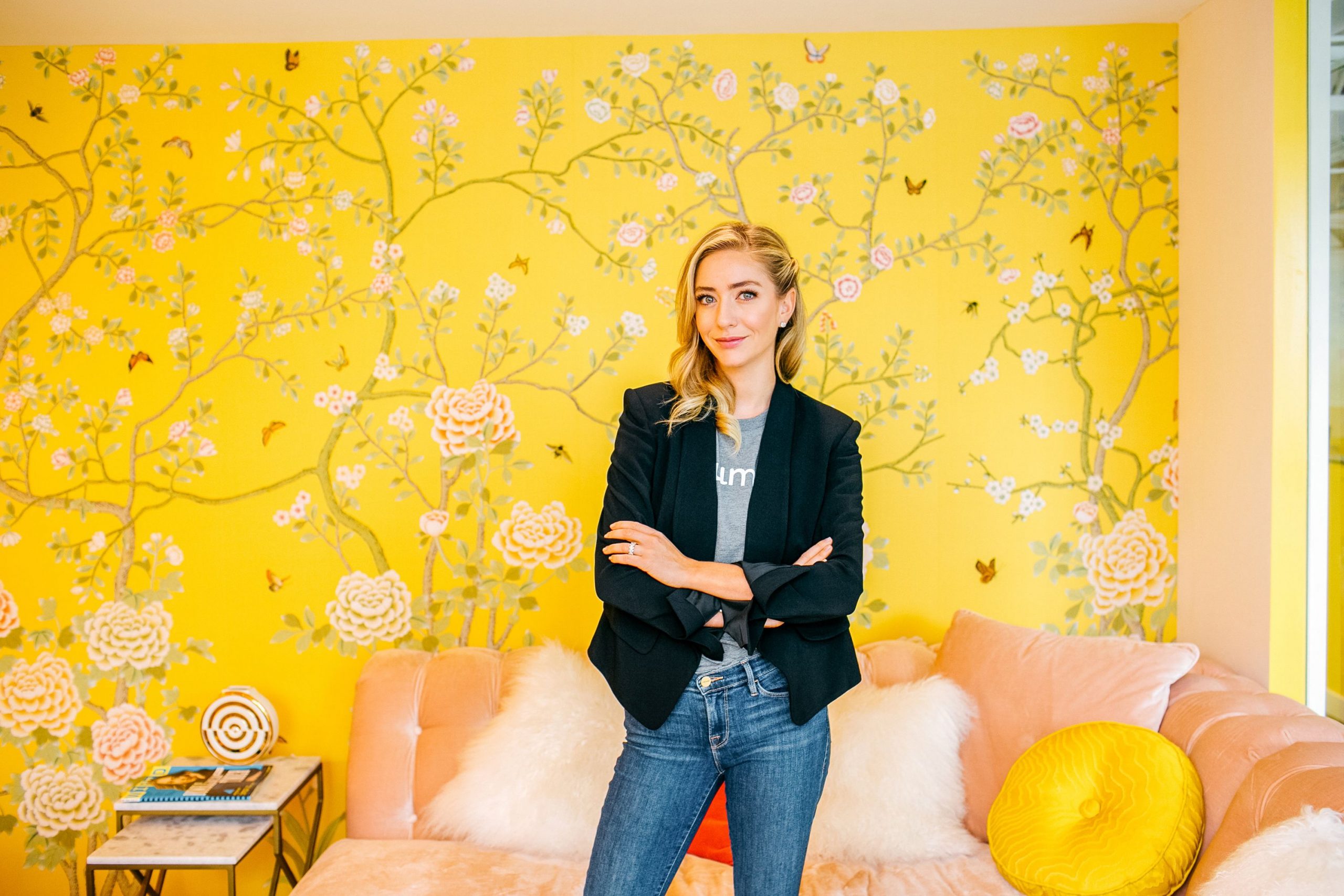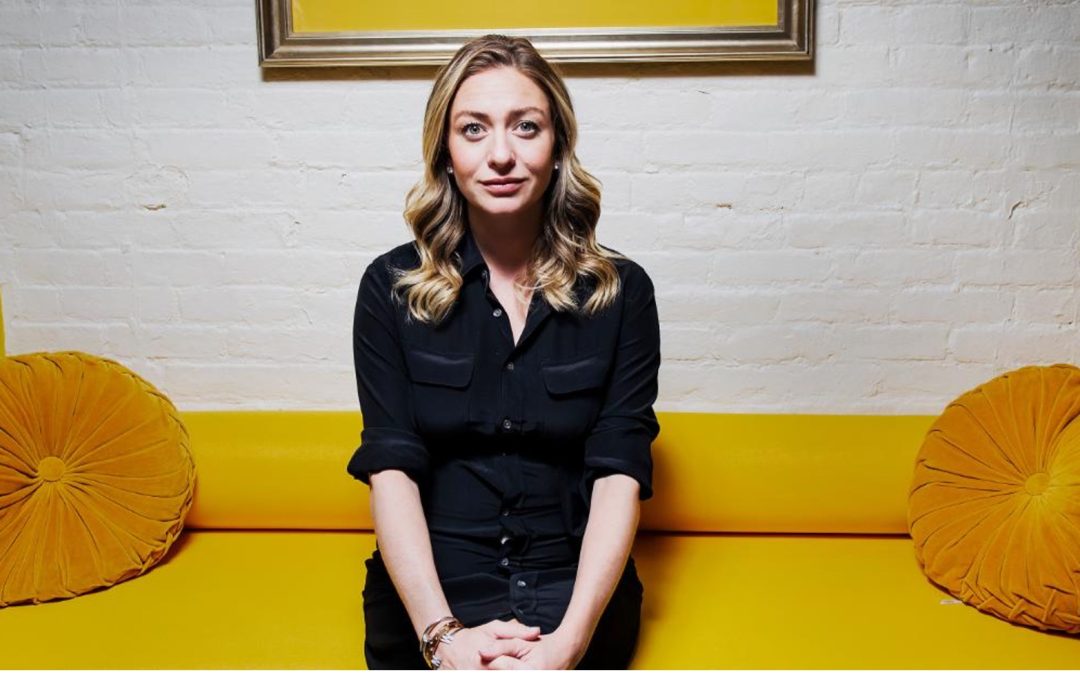Thanks to the current digital landscape, we can now date through our smartphones. For a long time, the two titans of the dating app industry have been Tinder and Bumble – both of which are linked to American entrepreneur and founder of Bumble, Whitney Wolfe Herd.
At the age of only 33 years, Herd has already started four companies and has helped launch two of the most-used dating apps worldwide. While attending Southern Methodist University in Texas, she began her business career by selling bamboo tote bags to benefit areas affected by the B.P. Oil Spill. A year later, she started a clothing line dedicated to raising awareness about human trafficking and fair trade. After graduation, she joined Hatch Labs and joined the development team for Tinder. She’s since been credited with fueling its popularity on college campuses and growing its user base.
Herd was co-founder and vice president of marketing at Tinder, an app that reinvented how people date and mate. She was part of one of the greatest business success stories during the digital age. However, it wasn’t always smooth sailing. In fact, she ended up suing Tinder for sexual harassment committed by Herd’s ex-boss and ex-boyfriend and alleging they had wrongfully stripped her of her co-founder title. Unfortunately, the company refused to admit to any wrongdoing. In fact, Tinder even blamed her for the animosity between Herd and her ex. Nevertheless, the suit was settled for approximately $1 million, and Herd moved on.
With something so public, she could’ve either given up or chosen to fight against it. The latter is precisely what Herd did. Rather than hiding away, she decided to enter one of the most crowded and established digital fields. She succeeded because she was able to create a safe space and platform that focused on women’s needs.
This article will look at how Whitney Wolfe Herd used PR and marketing to become Forbes’ 30 under 30 for two consecutive years.

1) Use of effective digital marketing
Since Bumble is an online application, they needed to truly understand digital marketing and use it effectively as part of their business strategy. They knew from the beginning that they wanted to target millennials from every demographic – millennials who were in search of a life partner, a best friend, or trying to grow their network professionally.
They could do that by effectively using content marketing to produce exciting and quirky content that connected customers to the brand. Besides being a dating platform, Bumble’s range helped to get people’s attention on the forum. After all, Bumble also helps people network within their profession and build platonic friendships.
Creating engaging content is paramount when trying to achieve media coverage. With the help of some of the best digital PR and marketing agencies, Bumble has transformed the dating experience and empowered women around the world. However, there may be startups and entrepreneurs that cannot afford to outsource their PR and marketing efforts due to a lack of finances. This is why PR agencies like Pressfarm exist to help companies achieve media coverage at an attractive price.
Pressfarm works with companies to help create newsworthy content to be distributed to journalists and media outlets. They also provide companies with access to their PR database of over 1 million journalists and media outlets so that they can find their perfect media match. Along with that, Pressfarm’s PR experts and writers also optimize branded content to achieve higher online visibility in relevant search results on search engine platforms.
Influencer marketing and social media marketing
The team at Bumble used their influencer marketing strategy to create hype about their three modes. It allowed them to diversify their brand and capture a much wider audience with different interests. With this strategy, they also created a more meaningful relationship between the brand, its influencers, and its consumers.
Along with that, they have been able to capture their audience using native content delivery via social media marketing. Through their previous research, Bumble understood who its target audience was, where to find them, and how to create compelling content. They aimed to target millennials who seriously used social media platforms like Facebook, Instagram, and Snapchat. Through Facebook, they delivered the latest news and invited people to participate in various events and visit the company’s other social media platforms. They created content using the company’s brand colors to create an engaging, entertaining, and cohesive brand image through a highly visual Instagram profile.
Facebook and Instagram also launched a series of advertisements on Snapchat. These advertisements created a niche market for users who only used the platform to create content like photos of actual users finding what they were looking for through the app. Bumble leveraged these features to provide potential users with incentives to download the app. This gave skeptical users a look into what Bumble could help them achieve, whether it was finding love, finding friends, or creating a professional network.
Digital marketing has worked well for Bumble because of its ability to understand how the market works and how best to approach it. It has helped the company and other networking platforms gain popularity within a short period.
2) Knowing the audience
Since Herd grew up in the digital generation, she already has first-hand experience of the best way to reach her target audience. The next thing she needed was something that would draw them in.
When Tinder first launched, there were already dating websites in the market. However, no company had successfully created an app specifically for smartphones yet. By doing the appropriate research into changing consumer needs, the Bumble team was able to develop an app that has changed the lives of many single people out there.
However, as mentioned previously, Herd did not leave Tinder on the best of terms. Nevertheless, she went on to launch an app that could easily rival them. This is due to one reason – her ability to understand the market and fill a gap with something that hadn’t existed yet.
Herd has been a feminist from a very young age. She has openly discussed how men have always dominated the dating culture. This is why she had initially planned to build a female-focused social network rather than just a dating app. The app’s women-focused model was initially inspired by the Sadie Hawkins school dances where women were the ones to ask men to be their dates. In an interview with Business Insider, Herd stated that the company’s goal was not to be sexist. Rather, it was meant to give power to women and change the dating standards. Herd and her team wanted to make dating feel more modern and with the times.
3) Smart collaborations
When Herd first decided to branch out independently, she didn’t know whether she would be successful because of the amount of online hate she had received. In the months between filing the suit against Tinder and settling, she was harassed by total strangers in the online community. She retreated to Texas to figure out her next steps until she received an email from the founder and CEO of Badoo, Andrey Andreev. This online dating network has over 360 million registered users in 190 countries.
She had initially turned down the offer to work together because she did not want to remain in the dating industry. Rather, she wanted to create a women-centric social brand. While she was adamant at first about not going back, Andreev managed to convince her to stick with what he and Herd were good at in the dating industry. Since the Tinder lawsuit settlement didn’t contain a noncompete clause, she took Andreev’s invitation to join the marketing and branding at Badoo. As a result, she had all the infrastructure, capital, and resources at her disposal. Andreev made an initial investment of about $10 million for launch marketing, taking 79% of the company, while Herd became founder, CEO, and 20%, owner.
Andreev’s decade of experience in the market helped Herd in so many ways. For example, she benefitted from A-B tests, data on the effectiveness of various monetization efforts, and expertise in bringing a product that did not have a lot of competition to scale. Thanks to Andreev and his empire, Bumble was also able to develop sophisticated technology when the time came.
4) Good crisis management
From the beginning of her career, Herd has been no stranger to controversy and public conflict. She has managed to remain successful because of her strong ability to manage any crises that come up.
Things had been quite successful for Bumble for quite a few years. In fact, it became the second most popular dating app in the U.S. with a monthly user base of 5 million. However, soon after, allegations of racism and sexism emerged against business partner Andreev, and Herd became part of another public crisis. The Forbes investigative report outlined workplace misogyny, drug use, and sexual and racial discrimination. This could have destroyed the company because of the industry they were in and the message that the brand had been putting out there. Herd released a statement saying that she had had nothing but respectful and good experiences with Andreev. At the same time, she stated that she would never attempt to challenge people’s feelings or experiences.
“All of us at Bumble are mortified by the allegations about Badoo…I am saddened and sickened to hear that anyone, of any gender, would ever be made to feel marginalized or mistreated in any capacity at their workplace.” – Whitney Wolfe Herd.
Through this crisis, Herd came out on top once again when Bumble’s parent company MagicLab was sold to private equity firm The Blackstone Group, and co-founder Andreev relinquished his entire stake in both Bumble and Badoo. Herd became the CEO of MagicLab, and she replaced MagicLab as the owner of both Bumble and Badoo.
5) Corporate social responsibility
Launching digital dating apps comes with a unique set of problems. Of course, Bumble has helped many users to find love. Nevertheless, digital sexual harassment issues also tend to arise.
Herd has thrived because of her understanding that these issues may arise. She wanted to show audiences that she was doing everything she could to create a safe place for people to communicate and meet people.
In 2019, Herd approached the Texas State Capitol to advocate a new law stating that sending unsolicited nude photos would be punishable by law. The law was passed in August 2019, and she is still advocating to implement it in other states around the U.S. Since then, she’s reached out to legislators to implement additional state-level bills in New York and California. She’s posted about this on her Instagram account, stating that, “If it’s a crime to expose yourself in public, it should be a crime to send unsolicited lewd photos and content online”. She says that the company wasn’t trying to stop free expression. Instead, they wanted to create online accountability and digital consequences that matched the real world. She also makes a call to action for her followers by telling them that they can support the movement by checking Bumble’s in-app card.
6) OOH advertising
While traditional players have continued to reach on-the-go consumers via mobile devices, Bumble reverted to “old-school” advertising to change the game. Since it is a digitally native brand, Bumble wanted to do something that many companies overlook – going back to the days of traditional marketing and advertising through ads across storefronts, subway stations, buses, and more. The aim was to highlight diversity in the app community. This strategy was successful due to the brand focusing on its location-based roots and targeting the ads to its users’ neighborhoods, favorite hangouts, and workplaces. According to Outfront Media CMO Jodi Sense:
“They took a media format that felt as impersonal as the New York subway and targeted it down to personas in particular locations, making a mass platform feel highly personalized.”
Bumble understood the importance of combining traditional and digital marketing. Along with the OOH ads they had created, they also began short-form docuseries and social content on Instagram to reach their digital audience. Bumble’s in-house creative team wanted to increase Bumble’s user base. This proved to be very successful due to their strong marketing strategy that continued to ignite loyalty and help retain a fanbase.
7) Company expansion
To give more opportunities for users of the app, Bumble created different modes of use. They added Bumble Bizz and Bumble BFF. In this way, they provided a hybrid of opportunities for influencer partnerships. This allowed them to reach an even bigger audience. By diversifying their brand, they were able to capture the attention of more people with differing interests and connect with influencers who had already been fans of the brand. As a result, influencer marketing campaigns started creating a more meaningful relationship between the brand, its influencers, and its consumers.
With Bumble Bizz, they could partner with influencers who already had large followings and had a career-oriented mindset. The mutually beneficial relationships allowed the brand to expand its awareness among brands trying to enter new markets or find industry professionals. Since influencer marketing has become a massive part of any company’s marketing strategy, Bumble’s move to connect with career-minded influencers was essential for networking and communication to help spread their message.
The structure of Bumble BFF also used influencer marketing as part of its campaign strategy. The company tried to find influencers on college campuses and major cities. They then encouraged these people to try the application to find like-minded individuals and stay connected. By focusing on that audience, they could spot thought leaders who already had a dedicated audience and create meaningful engagements that could result in longer-lasting partnerships. Finding the appropriate influencer helps set companies apart. This is because they can seamlessly connect a brand’s message and goals to target audiences.
8) Helping audiences
As mentioned previously, the digital age has caused almost everyone to gravitate towards the Internet and their smartphones for everything they need. This was especially the case during the last two years of social distancing and self-isolation due to the COVID-19 pandemic. While COVID-19 is still coming in waves, people are getting back to business as usual. However, one thing that hasn’t changed since the onset of the pandemic is the amount of time people spend online. In fact, most activities have been moved to digital platforms. As a result, online dating has experienced a massive boost.
At the height of the pandemic, Bumble released features on their app to improve the way people could connect while social distancing. They included a “Virtual Dating” badge for users’ profiles that were open to date exclusively online. The badge allowed users to find and filter matches that were looking to date virtually. By offering new tools, the dating platform noticed a 29% increase in usage during the worst of the pandemic. They have since continued looking for and creating tools to enhance users’ chat experiences and help them get to know other users better.
9) Revenue model
While Bumble launched in 2014, it did not begin monetizing via in-app purchases until August 2016. Even now, the app is free to download and use for its primary features. Nevertheless, Bumble has been so successful because of its three revenue models; the Freemium model, its in-app purchases, and its subscription-based model. Users can use the app without having to pay anything. Through these revenue models, Bumble has retained loyalty and has transformed the dating experience, empowering ladies around the world.

Conclusion
Whitney Wolfe Herd has proven that coming out of hardship can have very successful results. When creating Bumble, she was committed to providing a safe and empowering platform for women worldwide, and she has stuck by that from day one. Bad publicity can cause a company to either fail or revert to the drawing board to manage the crisis and come up with another game plan. Herd took her experience with Tinder and created a brand that aligns with her views and helps people worldwide to find precisely what they are looking for.
How Pressfarm can help
For an entrepreneur, the brand image you create can determine your success or failure. At Pressfarm, we help companies define the right narrative in the media for their brand – either to improve their credibility or resolve a PR crisis. If you are an entrepreneur wondering how to improve your company’s publicity, get in touch with us. We can help you to craft and distribute your press releases. We can also help you to develop compelling guest posts and design eye-catching media kits for your brand.
Learn why we are good at what we do from our customer success stories.

